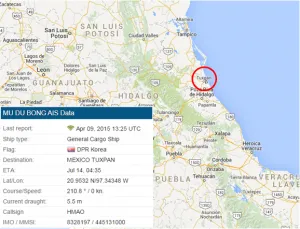20 April 2015
North Korean ship still being detained in Mexico
On 10 April, North Korea urged Mexico to free the Mu Du Bong, a North Korean cargo ship that has been detained in a Mexican port since it ran aground there in July of last year.

Pyongyang has accused Mexico of illegally holding the Mu Du Bong, calling the detention a “rampant violation” of sovereignty. North Korea has claimed that there are no legitimate grounds on which to prevent the ship from leaving Mexico, insisting that the vessel is a ‘totally a peaceful and legitimate commercial ship which sails under the direction of the Ministry of Land and Sea Transportation,’ and has no relation to Ocean Maritime Management (OMM), a North Korean shipping company currently blacklisted by the UN Security Council.
Background
According to ship tracking information, the Mu Du Bong is currently moored in the estuary of the Pantepec River, which runs through the Mexican Port City of Tuxpan. The Mu Du Bong had supposedly been on its way to take on a cargo load of fertilizer at Tuxpan, on the east coast of Mexico, but ran aground on 14 July 2014. The vessel has been detained in Mexico since the incident. Ship tracking information records that the Mu Du Bong passed through the Panama Canal in late June 2014, before calling at Cuba. It was then that the ship vanished from commercial tracking systems for over a week, in contravention of international law: vessels over a certain displacement are obliged to keep this tracking system (AIS) on at all times, to signal their identity and real-time location for the purposes of maritime safety. The AIS blackout lasted for nine days, between the July 1-9th. Switching off AIS is illegal and the vessel’s flag country is required by international law to investigate such cases. It seems unlikely that North Korea would have conducted such an investigation, however.

Reasons for detention
A major reason for the Mu Du Bong’s ongoing detention in Mexico is the belief that it belongs to North Korea’s Ocean Maritime Management (OMM) Company. OMM was designated by the UNSecurity Council pursuant Resolution 1718 and 2094 as a result of a previous incident involving an OMM-owned vessel, the Chong Chon Gang.
That incident that bears striking similarities with the circumstances surrounding that of the Mu Du Bong. In July 2013 the Chong Chon Gang was seized in Panama after some 240 tonnes of military equipment, including two MiG-21 fighter aircraft, were discovered hidden under sacks of sugar. The UN Panel of Experts on North Korea determined that the shipment had violated UN sanctions. Much like the Mu Du Bong, the Chong Chon Gang disappeared from the commercial shipping grid by switching off its on-board transponder – this time, just before reaching Cuba. The transponders were then turned back on after having left the country with its illicit cargo.
After the shipment was discovered, the Cuban Government acknowledged that it was sending ostensibly obsolete Soviet-era weapons to be repaired in North Korea, which would then be returned to Cuba. The UN Security Council committee responsible for blacklisting OMM concluded that OMM, as well as North Korean officials within Cuba, played a key role in arranging the shipment. A subsequent UN report, released in March of 2014, claims that North Koreahas developed sophisticated ways to circumventUnited Nationssanctions, including the suspected use of its embassies abroad to facilitate an illegal trade in weapons. The Chong Chon Gang along with its crew was released after being detained in Panama for a year.
According to ship-tracking information, the Mu Du Bong has spent the past three years mostly along the coast of China, close to North Korea. In April 2014 it made a call at the Russian Far East port of Nakhodka, before crossing the Pacific, transiting the Panama Canal in mid-June, and heading for Cuba. On June 25, the vessel signalled on AIS a few miles off the port of Mariel – the same port at which the Chong Chon Gang made a covert stop in order to pick up its arms shipment. Then, on 29 June, the vessel signalled again from Havana. There are obvious similarities between the Chong Chon Gang and anumber of other North Korean-flagged freighters which over the years have followed this pattern of dropping off the vessel identification system in the vicinity of Cuba.
Hugh Griffiths, an expert in air and sea trafficking at the Stockholm International Peace Research Institute, and also a member of the UN Security Council’s Panel of Experts on North Korea, has described this practice as “a common risk indicator of maritime trafficking.” (Iran’s oil tankers have used the same tactic to mask sanctions-busting activities).
North Korea has recently insisted that the Mu Du Bong is in no way associated with OMM. However, a recent report by the UN Panel of Experts on North Korea stated that the Pyongyang-based Ocean Maritime Management after its designation by the UN has simply renamed most of its vessels to avoid detection. For example, in October 2014, North Korea changed the name of the Chong Con Gang to the Tong Hung San. (A table highlighting all North Korea’s vessel name changes can be found within the latest Panel of Experts report). Ownership of vessels previously operated by OMM has also been transferred to other single-owner companies, often with names derived from ship names. North Korea, as well as other UN-sanctioned states, particularly Iran, has a documented history of using front companies for the purposes of evading sanctions.
This case, along with that of the Chong Chon Gang, highlights the hidden complexity involved in ensuring compliance with sanctions as well as the need for national authorities and service providers to conduct due diligence checks on all ships with which they interact, whether it is providing port services, insurance, or other services.
